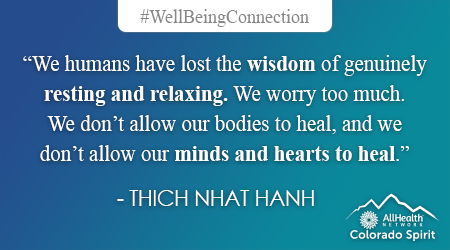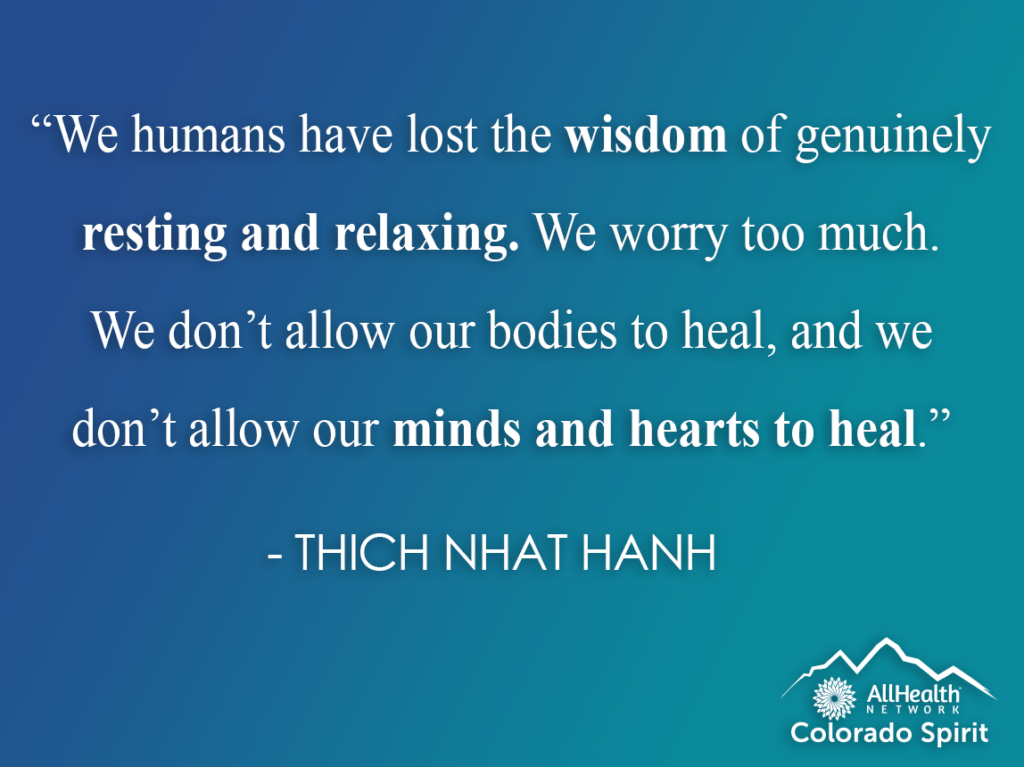Welcome to the Weekly Well-Being Connection! Each week we will share advice from our clinical experts on ways to care for your mental health and well-being throughout COVID-19.
Many of us have heard the research about how too much screen time can have negative impacts on our health and well-being. At the same time, given the pandemic and the need to practice physical distancing to protect ourselves and our loved ones, most of us are spending a ton more time on screens these days. Between video conferencing for work and social connections, remote learning, and few live entertainment opportunities, it can feel challenging to find time away from screens.
Our AllHealth Network team has been thinking a lot about this dilemma lately and wanted to share some of our suggestions and favorite non-screen time activities.
- Reading – as a bookworm, I always love the opportunity to curl up with a book. There are wellness benefits like enhanced empathy and increased mental flexibility associated with reading too (see this article for more benefits). A lot of us bookworms have noticed that our concentration, focus, and subject interest is different in the pandemic though, so our recommendation is to be gentle with yourself. Even reading for brief periods of time can be enjoyable and beneficial and maybe it is time to try out a new genre. For example, I have been enjoying more fiction collections of short stories compared to some of my typical psychological thriller go to reads.

- Building sets – some of our team members have worked on LEGO creations (both solo and with family members), building models, or using magnetic tiles to build masterpieces. Not only does this activity get us away from screens, it helps us with spatial skills and provides a creative outlet.
- Speaking of creativity, consider other creative arts – Taking a cue from my kids, I have worked on a few craft projects lately. Whether it is drawing, coloring (there are lots of “adult” coloring books and coloring pages), papercrafting, painting, playing an instrument, photography, woodworking, sculpting, sewing, quilting, or writing, finding ways to engage in creative practices can help us get away from screens and reap the benefits of creative expression.
- Jigsaw Puzzles – a few of us have tried out some large jigsaw puzzles. Whether it is a group or solo activity or something you finish in one sitting or work on for a period of days (or weeks if you are like me), puzzles can be a change of pace. They are also available in a lot of different styles, sizes, and price ranges (a friend of mine just found a fun puzzle at a dollar store!).
- Board games or card games – while these might lend themselves better for a group activity, there are literally thousands of options to choose from. This website lists several different games to play with a standard deck of cards and includes several versions of solitaire. I personally have learned that I am better than a 6th grader at Qbitz but the same middle schooler easily defeats me about 90% of the time at Qwirkle (who knew there were so many board games that begin with a Q). One of our team members recently found a family friendly version of Cards Against Humanity and has shared stories of many game nights she has had with her teenager!
- Keep getting outside, even when it is cold – Colorado in winter is an interesting place. It can be in the teens one minute and close to 60 and sunny the next. Take advantage of that as you can. Activities like hiking, running, or just taking a walk are still options. Stanford scholar Kari Leibowitz shares what she calls the Norwegian mindset about winter here . I know her writing inspired me to bundle up and focus on what I enjoy outside, even when it is cold.
How do we create non-screen time space in our days?
Now that we got you thinking of things to do away from screens, how do we create non-screen time space in our days? We shared a few links in the resource section that give a lot of great suggestions, but here are our favorite tips.
- Set an intention – It is easy to get pulled into doing “extra” things on our screens and devices. Making a plan about when we log off and power down devices and intentionally stepping away from them can help us follow through on spending our time in different ways.
- Create a device free zone – While this will look different based on different living spaces, having an area in your living environment that is screen free can help us engage in different activities.
- Use technology to help – As counterintuitive at it seems, there are numerous apps and websites that can help us with our screen time limits. Even the practice of setting your phone to “do not disturb” can help you avoid notifications that might pull you back to your screens.
- Commit to engaging in specific tasks without devices – For example, can mealtimes be screen-free times?
Would speaking to someone help?
To speak with someone in the Colorado Spirit Program about stress related to the pandemic, please call 720-707-6789 or visit our web page at www.allhealthnetwork.org/Colorado-Spirit
For information about other services at AllHealth Network or to get connected with ongoing behavioral health support, please call: 303-730-8858.
AllHealth Network is continuing to provide service via telehealth or by phone and our Crisis Walk-in Center remains open 24/7. To learn more about what other community mental health centers are doing, please visit The Colorado Behavioral Health Council COVID-19 website.
If you are experiencing a mental health crisis and are in need of immediate assistance, please call the Colorado Crisis Hotline at 1-844-493-TALK (8255) or text TALK to 38255


